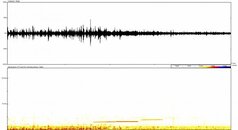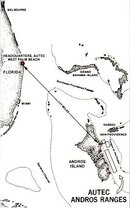
Hopefully the upload will work - first time I have tried it.
The picture above shows the analysed sound signal from one set of signals. Each instance of the sound is identical -
The first sound is constant frequency at 3 kHz and lasts 500 ms. There is then a silent gap of 10 ms, followed by a second constant frequency pulse at 3.2 kHz which again lasts for 500ms. The final sound component is a constant frequency signal 60 ms later at 3.9 kHz. The sound then repeats at a repetition rate of just under a minute.
I have looked at each 'sound' instance in turn, and the signal each time is identical, same frequency, duration and inter-pulse interval. The repetition rate is around a minute between signals for the first few recordings, then changes to roughly 30 seconds between instances. After the change to 30 second repetition rate the sound characteristics still remain the same. i.e. 3, 3.2 and then 3.9 kHz and 500 ms pulses with the same inter pulse intervals. So the characteristics of the signal are unchanged except the repetition rate.
There are no echoes, harmonics or doppler shift effects visible in the signals, which suggests that they are not being received from reflections or 'bounce' from the sea bottom or water surface (in the way radio waves bounce in the atmosphere) which would suggest a straight line sound propagation perhaps from a towed buoy or submerged sender.
I have looked at some mid-frequency sonar sonograms and they show the same pattern of three (or more) cf components of similar frequency, length and duration but I have no experience or knowledge of what they are used for except that they will return distance and depth profile type information so as these are what is called active sonar, they may have been being used for sonar mapping or bottom surveys which is why they were repeated regularly, rather than a military search and locate type use.
Although I seem to remember from the old WWII films that ships turned on active sonar to "drive" submarines in particular directions when they were trying to push them into traps and so on - so someone may have been playing war-games. Any ex sailors out there can throw some light on this?
Phil.
edit - ok - jpeg not very clear - I'm happy to supply original to anyone really interested - pm me - cheers P










